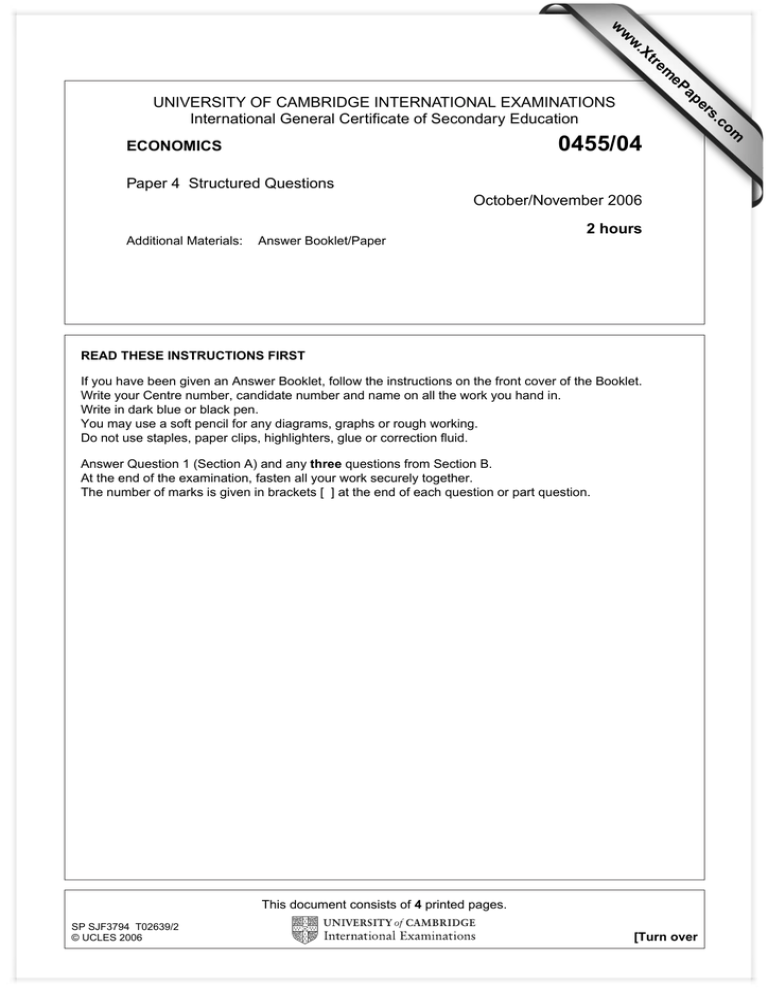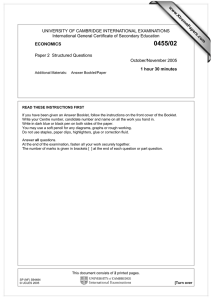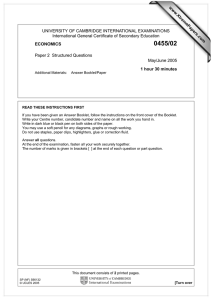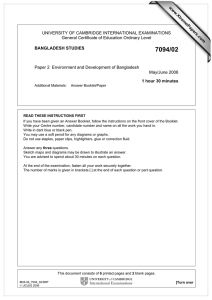
w
w
ap
eP
m
e
tr
.X
w
0455/04
ECONOMICS
Paper 4 Structured Questions
October/November 2006
2 hours
Additional Materials:
Answer Booklet/Paper
READ THESE INSTRUCTIONS FIRST
If you have been given an Answer Booklet, follow the instructions on the front cover of the Booklet.
Write your Centre number, candidate number and name on all the work you hand in.
Write in dark blue or black pen.
You may use a soft pencil for any diagrams, graphs or rough working.
Do not use staples, paper clips, highlighters, glue or correction fluid.
Answer Question 1 (Section A) and any three questions from Section B.
At the end of the examination, fasten all your work securely together.
The number of marks is given in brackets [ ] at the end of each question or part question.
This document consists of 4 printed pages.
SP SJF3794 T02639/2
© UCLES 2006
[Turn over
om
.c
s
er
UNIVERSITY OF CAMBRIDGE INTERNATIONAL EXAMINATIONS
International General Certificate of Secondary Education
2
Section A
Answer this question.
1
Trade and production in Bangladesh
At one time, international trade agreements ensured an export market for clothes made in
Bangladesh, but these were due to end in 2005. It was feared that many workers in Bangladesh
would lose their jobs as a result. The Foreign Minister hoped that the trade in medicines would
grow sufficiently to reduce that unemployment. The Foreign Minister said that in 2004 Bangladesh
was exporting medicines to 60 countries and could produce them up to 70% cheaper than the
Developed World. He said that if Bangladesh, a developing country, could get 2% of the global
trade in medicines it could be worth many times the clothing exports that Bangladesh had lost.
In 2004, 150 local firms and 6 multi-national companies manufactured medicines in Bangladesh.
However, the production of medicines employed just 50 000 workers and most future jobs would
require highly trained technicians. The clothing trade employed 1.8 million unskilled workers and
accounted for more than 75% of Bangladesh’s exports.
(a) State four ways in which multi-national companies can help developing countries such as
Bangladesh.
[4]
(b) International trade agreements can protect jobs. Despite this, some economists prefer free
trade to trade agreements. Explain why.
[6]
(c) Summarise the main argument of the Foreign Minister of Bangladesh.
[4]
(d) Why might it be difficult for employment in the clothing industry to be replaced by employment
in the manufacture of medicines?
[6]
© UCLES 2006
0455/04/O/N/06
3
Section B
Answer any three questions.
2
(a) Explain the difference between an equilibrium price and a disequilibrium price.
[4]
(b) Many more people travel by aeroplane today than ten years ago. With the help of a demand
and supply diagram, explain what might have happened in the market for air travel to cause
this increase.
[6]
(c) Define price elasticity of demand and suggest why different goods have different price
elasticities.
[5]
(d) Discuss whether knowledge of price elasticity of demand is of use to a company selling
holiday tours.
[5]
3
(a) State four non-wage influences on an individual’s choice of occupation.
[4]
(b) Explain what is meant by the primary, secondary and tertiary sectors of production and
describe how the importance of each sector changes as a country develops.
[6]
(c) Explain what is meant by a trade union.
[3]
(d) Discuss the extent to which the relative strengths of trade unions influence the level of
earnings in different occupations.
[7]
4
In 2004, economists were concerned about the inflationary impact of unusually high oil prices,
which were caused by political uncertainty in the Middle East.
(a) Explain how inflation is measured.
[6]
(b) Low inflation is one of the aims of government policy. Choose two other macro-economic
aims of the government and explain what they mean.
[4]
(c) Explain how high oil prices may cause inflation.
[4]
(d) Discuss the actions that a government might take to control inflation.
[6]
© UCLES 2006
0455/04/O/N/06
[Turn over
4
5
In China, the State Council has ordered a reduction in urban development projects in Beijing. This
is because, as developers clear land, people’s homes are destroyed. It will also support the
government’s aim of reducing total demand in the economy.
(a) Explain what is meant by the conservation of resources.
[4]
(b) Urban development is often thought to be beneficial. Consider who might benefit from an
urban development project.
[6]
(c) Explain how a government might control private companies that wish to develop an area. [3]
(d) Discuss why the development and exploitation of an urban area might be disadvantageous.
[7]
6
7
(a) Distinguish with the use of examples between
(i)
direct and indirect taxes,
[3]
(ii)
progressive and regressive taxes.
[3]
(b) Explain why governments impose taxes.
[6]
(c) Discuss what might happen in an economy if a government increases income tax rates.
[8]
(a) What is meant by fixed cost, variable cost and average total cost?
[4]
(b) Discuss what might happen to these costs if a firm replaces labour with machines.
[6]
(c) Some firms integrate with others. Explain the different forms of integration, and suggest why
integration happens.
[10]
Copyright Acknowledgements:
Question 1
© Reprinted with permission of Far Eastern Economic Review, Copyright © (2004) Dow Jones & Company, Inc. All Rights Reserved Worldwide.
Permission to reproduce items where third-party owned material protected by copyright is included has been sought and cleared where possible. Every
reasonable effort has been made by the publisher (UCLES) to trace copyright holders, but if any items requiring clearance have unwittingly been included, the
publisher will be pleased to make amends at the earliest possible opportunity.
University of Cambridge International Examinations is part of the University of Cambridge Local Examinations Syndicate (UCLES), which is itself a department of
the University of Cambridge.
© UCLES 2006
0455/04/O/N/06











